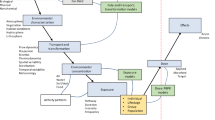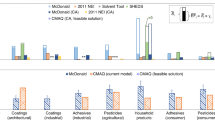Abstract
Purpose
Indoor emissions of toxic substances from products can have a negative effect on human health. These are typically not considered in a life cycle assessment (LCA), potentially underestimating the importance of the use stage. The purpose of this paper is to develop a method that, based on a set of measured emission rates, calculates the impact on human health during the use stage of products that are used indoors and that emit volatile organic compounds (VOCs).
Methods
Emissions from a product are measured in a test chamber and reported as a set of emission rates (microgrammes per hour) at specific points in time (hour/day). Constrained non-linear regression (CNLR) analysis is then used to determine parameters for three emission models, and a model is selected based on goodness of fit with the measured emission rates (R 2 and expert judgement). The emission model is integrated over a defined time period to estimate the total use stage emissions per functional unit (FU). The total emissions are subsequently integrated in a homogeneously mixed one-box model within the USEtox model. Intake fraction (iF) is calculated based on size of residential home, inhalation rate, exposure time, ventilation rate, mixing factor and number of people exposed.
Results and discussion
The method is tested in a case study of a chair, with the results showing that the impacts in the use stage are in most cases significantly higher than from the production and disposal stages combined. The sensitivity to parameter variations is evaluated. Intake fraction (factor of 761), replacement frequency (factor of 70) and emission model (factor of 24) are found to be the most important model parameters. Limiting early exposure (>14 % of emissions may occur in the first month and >50 % in the first year) and replacing furniture less frequently will reduce exposure.
Conclusions
The case study shows that the impact on human health from indoor emissions can be of significance, when compared to the impact on human health from total outdoor emissions. Without specific exposure data (e.g. ventilation rates) the uncertainty will be high. The developed method is applicable to all products that emit VOCs, provided that the emission rate can be modelled using an exponential decay model and that the product amount is related to a meaningful functional unit. It is recommended that when performing an LCA of products that emit VOCs, the indoor use stage is included in the life cycle impact assessment.






Similar content being viewed by others
References
Afsset (2009) Saisine Afsset no. 2004/11. Afsset, Paris
AgBB (2010) Evaluation procedure for VOC emissions from building products. http://www.agbb-nik.de/. Accessed 20 September 2012
Allan M, Richardson GM (1998) Probability density functions describing 24-hour inhalation rates for use in human health risk assessments. Hum Ecol Risk Assess 4(2):379–408
Andrews E, Lesage P, Benoît C, Parent J, Norris G, Revéret J-P (2009) Life cycle attribute assessment—case study of Quebec greenhouse tomatoes. J Ind Ecol 13(4):565–578
Bennett DH, McKone TE, Evans JS, Nazaroff WW, Margni MD, Jolliet O, Smith KR (2002) Defining intake fraction. Environ Sci Technol 36(9):206a–211a
Berglund B, Johansson I, Lindvall T (1989) Volatile organic compounds from used building materials in a simulated chamber study. Environ Int 15:383–387
Blondel A, Plaisance H (2011) Screening of formaldehyde indoor sources and quantification of their emission using a passive sampler. Build Environ 46(6):1284–1291
Brasche S, Bischof W (2005) Daily time spent indoors in German homes—baseline data for the assessment of indoor exposure of German occupants. Int J Hyg Environ Heal 208(4):247–253
Brown SK (1999) Chamber assessment of formaldehyde and VOC emissions from wood-based panels. Indoor Air 9(3):209–215
Chang JCS, Sparks LE, Guo Z, Fortmann R (1998) Evaluation of sink effects on VOCs from a latex paint. J Air Waste Manag Assoc 48(10):953–958
Chen J-C, Wey M-Y, Chiang B-C, Hsieh S-M (1998) The simulation of hexavalent chromium formation under various incineration conditions. Chemosphere 36(7):1553–1564
Choi H, Schmidbauer N, Sundell J, Hasselgren M, Spenger J, Bornehag C-G (2010) Common houshold chemicals and the allergy risks in pre-school children. PLoS One 5(10):e13423
Colombo A, De Bortoli M, Knöppel H, Pecchio E, Visser H (1993) Adsorption on selected volatile organic compounds on a carpet, a wall coating, and a gypsum board in a test chamber. Indoor Air 3:276–282
ECA (1997) Evaluation of VOC emissions from building products. European Comission, Brussels
EPD Norway (2008) Product category rules for preparing an Environmental Product Declaration (EPD) for product group seating solution. EPD Norway, Oslo
Eurofins (2012) Eurofins. http://www.eurofins.com. Accessed 20 September 2012
Fet AM, Skaar C, Michelsen O (2009) Product category rules and environmental product declarations as tools to promote sustainable products: experiences from a case study of furniture production. Clean Technol Environ 11(2):201–207
Greenguard (2011) GREENGUARD Environmental Institute Formaldehyde Free Verification Requirement. Marietta
Guo Z (2002a) Review of indoor emission source models. Part 1. Overview. Environ Pollut 120(3):533–549
Guo Z (2002b) Review of indoor emission source models. Part 2. Parameter estimation. Environ Pollut 120(3):551–564
He G, Yang X, Shaw CY (2005) Material emission parameters obtained through regression. Indoor Built Environ 14(1):59–68
Hellweg S, Demou E, Bruzzi R, Meijer A, Rosenbaum RK, Huijbregts MAJ, McKone TE (2009) Integrating human indoor air pollutant exposure within life cycle impact assessment. Environ Sci Technol 43(6):1670–1679
Hun DE, Corsi RL, Morandi MT, Siegel JA (2010) Formaldehyde in residences: long-term indoor concentrations and influencing factors. Indoor Air 20(3):196–203
International Organization for Standardization (2001) Indoor air—part 3: determination of formaldehyde and other carbonyl compounds - Active sampling method (ISO 16000–3:2001). International Organization for Standardization, Geneva
International Organization for Standardization (2004) Indoor air—part 6: determination of volatile organic compounds in indoor and test chamber air by active sampling on Tenax TA sorbent, thermal desorption and gas chromatography using MS/FID (ISO 16000–6:2004). International Organization for Standardization, Geneva
International Organization for Standardization (2006a) Environmental management—life cycle assessment—requirements and guidelines (ISO 14044:2006). International Organization for Standardization, Geneva
International Organization for Standardization (2006b) Indoor air—part 9: determination of the emission of volatile organic compounds from building products and furnishing—emission test chamber method (ISO 16000–9:2006). International Organization for Standardization, Geneva
International Organization for Standardization (2006c) Indoor air—part 11: determination of the emission of volatile organic compounds from building products and furnishing—sampling, storage of samples and preparation of test specimens (ISO 16000–11:2006). International Organization for Standardization, Geneva
Jørgensen RB, Bjørseth O (1999) Sorption behaviour of volatile organic compounds on material surfaces—the influence of combinations of compounds and materials compared to sorption of single compounds on single materials. Environ Int 25:17–27
Jørgensen RB, Bjørseth O, Malvik B (1999) Chamber testing of adsorption of volatile organic compounds (VOCs) on material surfaces. Indoor Air 9(1):2–9
Jørgensen RB, Dokka TH, Bjørseth O (2000) Introduction of a sink–diffusion model to describe the interaction between VOCs and material surfaces. Indoor Air 10:27–38
Kim I, Hur T (2009) Integration of working environment into life cycle assessment framework. Int J Life Cycle Assess 14(4):290–301
Kuehn BM (2008) Stronger formaldehyde regulation sought. JAMA 299(17):2015–2015
Meijer A, Huijbregts MAJ, Reijnders L (2005) Human health damages due to indoor sources of organic compounds and radioactivity in life cycle impact assessment of dwellings—part 1: characterisation factors. Int J Life Cycle Assess 10(5):309–316
National Research Council (1991) Human exposure assessment for airborne pollutants: advances and opportunities. National Academy Press, Washington, DC
Nordic Ecolabelling (2011a) Nordic Ecolabelling of furniture and fitments. Nordic Ecolabelling, Oslo
Nordic Ecolabelling (2011b) Nordic Ecolabelling of panels for the building, decoration and furniture industries. Nordic Ecolabelling, Oslo
Øie L (1998) The ventilation rate of 344 Oslo residences. Indoor Air 8(3):190–196
PE International (2011) GaBi. http://www.gabi-software.com. Accessed 20 September 2012
Rosenbaum R, Bachmann T, Gold L, Huijbregts M, Jolliet O, Juraske R, Koehler A, Larsen H, MacLeod M, Margni M, McKone T, Payet J, Schuhmacher M, van de Meent D, Hauschild M (2008) USEtox—the UNEP-SETAC toxicity model: recommended characterisation factors for human toxicity and freshwater ecotoxicity in life cycle impact assessment. Int J Life Cycle Assess 13(7):532–546
Rydberg T, Westerdahl J, Hallberg E, Öman A, Andersson PL, Haglund P, Holmgren T, Fuhrman F, Molander S, Tivander J (2012) Emissions of additives from plastics in the societal material stock: a case study for Sweden. In: Bilitewski B, Darbra RM, Barceló D (eds) The handbook of environmental chemistry volume 18. Springer, Berlin, pp 133–149
Saarela K, Tirkkonen T (2004) M1, emission classification of building materials: protocol for chemical and sensory testing of building materials. VTT, Finland
Salthammer T, Mentese S, Marutzky R (2010) Formaldehyde in the indoor environment. Chem Rev 110(4):2536–2572
Sexton K, Adgate JL, Church TR, Ashley DL, Needham LL, Ramachandran G, Fredrickson AL, Ryan AD (2005) Children’s exposure to volatile organic compounds as determined by longitudinal measurements in blood. Environ Health Perspect 113(3):342–349
Sexton K, Adgate JL, Ramachandran G, Pratt GC, Mongin SJ, Stock TH, Morandi MT (2003) Comparison of personal, indoor, and outdoor exposures to hazardous air pollutants in three urban communities. Environ Sci Technol 38(2):423–430
Singer BC, Hodgson AT, Hotchi T, Ming KY, Sextro RG, Wood EE, Brown NJ (2007) Sorption of organic gases in residential rooms. Atmos Environ 41(15):3251–3265
SPSS (2010) SPSS 14.0 for Windows
Tichenor BA, Guo Z (1991) The effect of ventilation on emission rates of wood finishing materials. Environ Int 17(4):317–323
Tichenor BA, Guo Z, Dorsey JA (1992) Emission rates of mercury from latex paints. U.S Environmental Protection Agency, Washington DC
Tichenor BA, Guo Z, Dunn JE, Sparkds LE, Mason MA (1991) The interaction of vapour phase organic compounds with indoor sinks. Indoor Air 1:23–37
USEtox (2011) USEtoxTM model. http://www.usetox.org. Accessed 8 February 2011
Wenger Y, Li D, Jolliet O (2012) Indoor intake fraction considering surface sorption of air organic compounds for life cycle assessment. Int J Life Cycle Assess 17(7):919–931
WHO (2010) WHO guidelines for indoor air quality: selected pollutants. The WHO European Centre for Environment and Health, Bonn
Acknowledgments
The PhD position of Christofer Skaar is part of a research programme sponsored by the Norwegian Research Council. Project name: C(S)R in global value chains, a conceptual and operational approach. Project number: 171658.
Author information
Authors and Affiliations
Corresponding author
Additional information
Responsible editor: Michael Z. Hauschild
Electronic supplementary material
The Supplementary Material contains details on the measured emission rates (Table S1), the evaluation of goodness of fit of the emissions models using R 2 (Table S2), a comparison of the USEtox effect factors to LCI values from ECA (1997), AgBB (2010) and Afsset (2009) (Table S3), impacts in the use stage over a 70 year time span (Table S4), impacts in the use stage over a 15 year time span (Table S5) and LCA results for the production and disposal stages (Table S6).
ESM 1
(DOCX 46 kb)
Rights and permissions
About this article
Cite this article
Skaar, C., Jørgensen, R.B. Integrating human health impact from indoor emissions into an LCA: a case study evaluating the significance of the use stage. Int J Life Cycle Assess 18, 636–646 (2013). https://doi.org/10.1007/s11367-012-0506-8
Received:
Accepted:
Published:
Issue Date:
DOI: https://doi.org/10.1007/s11367-012-0506-8




